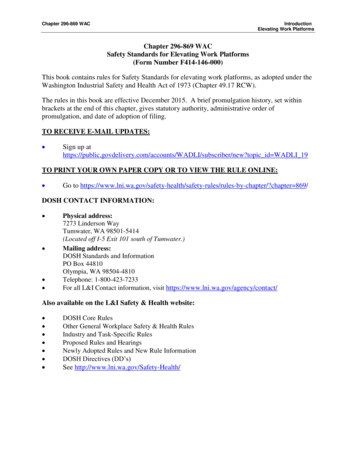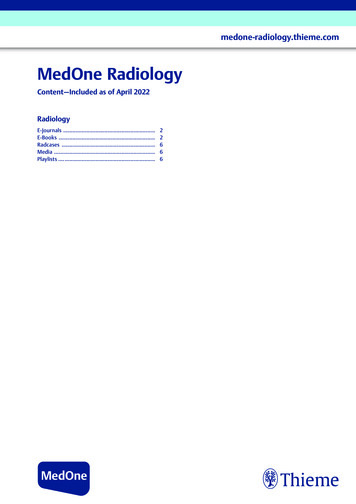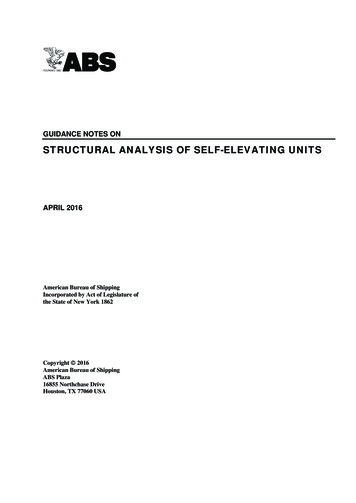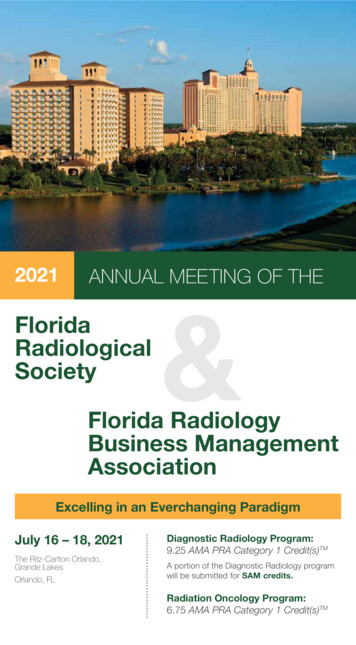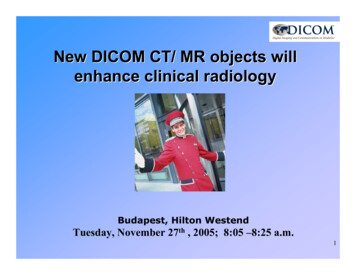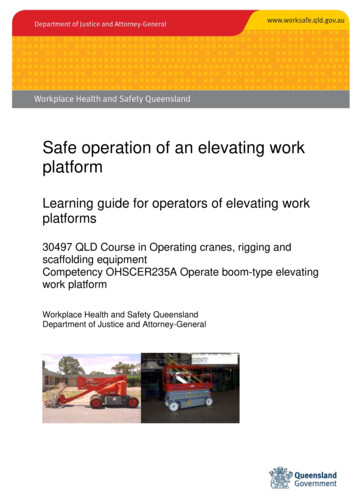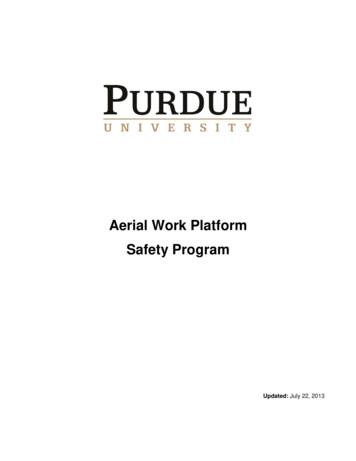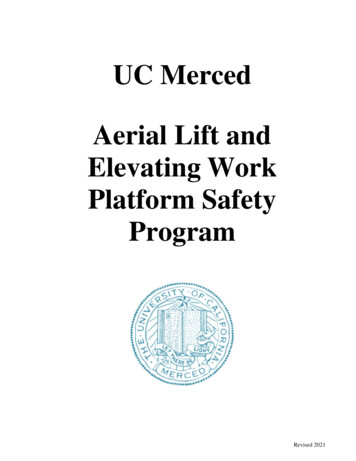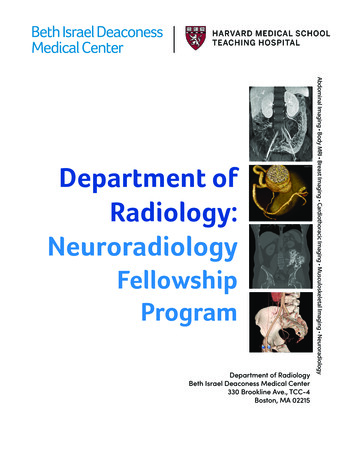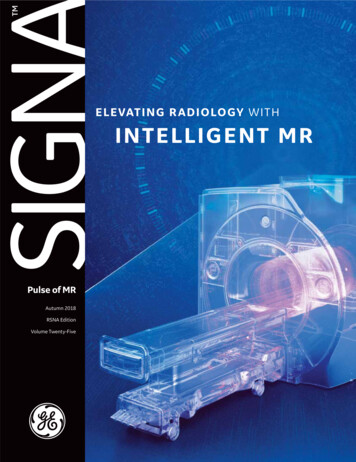
Transcription
ELE VATING R ADIOLOGY WITHINTELLIGENT MRPulse of MRAutumn 2018RSNA EditionVolume Twenty-Five
Issue Spotlight15Outside the Bore48991012Celebrating 35 yearsof MR leadership18Moving the needle in coildevelopment: the visionbehind AIR Technology In Practice23Delivering integrated medicinewith MR as the foundation foradvanced imaging28Magnet longevity key to GoldSeal and SIGNA Lift programs31RadNet skyrocketsthe patient experience34High-end MSK imaging deliversa winning record for X Radiology38Using big data to improveoperational efficiency &clinical excellence42Fast & affordable 10-minutebreast MR examA lighter, more flexible andcomfortable way to scanStudy demonstrates thevalue of ZTE MRA inaneurysm follow-up casesAIR Touch drives consistencyand eliminates variation inscan prescriptionIntroducing intelligent MRpowered by deep learningSharing ideas thatfoster innovationNew Editorial Board Membersfor SIGNA Pulse of MRPublications Team:Stephanie er, Global MRKerry AdapathyaAssociate EditorMarketingCommunicationsLeader, Global MRAnna BrownAssociate EditorMarketing Operationsand Brand ManagementDirector, Global MRgehealthcare.com/mrGE Contributors:Mary Beth MassatAssociate EditorHeide HarrisClinical EditorClinical MarketingApplications TrainingManager, Global MRSteve LawsonClinical EditorClinical MarketingManager, Global MRRocketLawnchairDesign & ProductionRishi AwasthiRegional ProductManager, MRAlmos Elekes, PhDProduct MarketingManager, Global PET/MR, Oncology andMolecular MRBrian Burns, PhDSenior Scientist, MREduardo FigueiredoClinical DevelopmentSpecialist, MRAnne DavidsonSales Specialist, MROzgur DemirkilincClinical Leader, MRSubodh DivgiNational ProductManager, MRThomas DoringClinical ProductManager, MRSabina PratoCustomer SuccessLeaderBob StormontPrincipal Engineer, MRVineeth V.S.Advanced Lead ClinicalSpecialist, MRFraser RobbManager, RF Coils, MRXiao WangProduct MarketingLeader, MRYu KaibaraProduct MarketingManager, MRGlen SabinDirector, RegulatoryAffairs, MRDan WeyersProduct Manager,RF Coils, Global MRDoug Kelley, PhDProduct Manager,Global 7.0T MRJames SedorovichClinical ProductMarketing Leader, MRHendrik WolfsGeneral Manager,3.0T MR SegmentEngineeringBrian KingRegional ModalityLeader, MR2James McMahonSenior Director,Regulatory Affairs, MRTomorrow Today
Case Studies46Multi-parametric imagingin shorter scan times forprostate cancer imaging52High-resolution synthetic diffusionMR with FOCUS in the assessmentof anterior spinal cord ischemia57Free-breathing abdominalimaging with Auto NavigatorTech Trends60Diffusion imaging demystified66Artificial intelligence:shaping the future of healthcare69The sound of silence 2018 General Electric Company, doing business ass GE Healthcare. All rights reserved. The copyright,othersubsistingght, trademarks,tradememarks,, trade namess andan other intellectualllectual propertyy rightsrisisting in or useduse in connectionwith and related to this publication are, the property of GEforbiddenprior writtenHealthcare.G Healthcare unless otherwise specified. Reproductionproduct on in any form is forbiorbiwithouthout pririttenen permissionpn from GE HealtLIMITATION OF LIABILITY: The information in this magazineherein. Whileboard to seezine is intended as a general presentation of the contentonten includedncluded hereWhil everyery effort is made by the publisherslishers and editorialedthat no inaccurate or misleading data, opinion or statementsment occur, GE cannot accept responsibility for the completeness,ommpleteness, currencycucy oro accuracycuracy of theth informationformation supplied or forfo any opinion expressed.Nothing in this magazine should be used to diagnose or treatprofessionaleat any disease or condition. Readers are advised to consultonsult a healthcarehealssional with any questions.stions. Products mentioned in the magazinezinemay be subject to government regulation and may not be availablevaila in all locations. Nothing in this magazine constitutestes an offeroff to sell any product or service.gesignapulse.com3AutumnAutu2018
Celebrating35 yearsofMR leadershipOver the last 35 years, GE Healthcare has developed incrediblebreakthroughs that have changed the MR industry. The last fiveyears have proven to be some of the most productive in our history,from higher powered gradients to the latest AIR Technology Coils.These MR advances impress even the engineers who develop them.After three decades of developing MRA history of innovationIt’s an advanced MR system equippedtechnology with GE, Bob Stormont,MR has come a long way since the earlywith innovative coil and gradientPrincipal Engineer, still can’t believe it.days of development. Thanks to thetechnology that directly links toefforts of GE scientist Dr. John Schenckcloud-based analytics.“The physics of MR is extremelycomplicated. Getting the technologiesto work in concert and create an MRimage is really stunning. It’s almostmagical that we can do that, and I’mand his research team, GE launchedthe SIGNA 1.0 in 1983. The 1.5T wholebody system made history as the firstcommercially available MR scanner.still stunned every time I look at anSince then, each year reinforces GE’sMR image,” says Stormont.excellence in MR, and the last fiveRikk Wolfs, General Manager, MR 3.0TSegment Engineering, joined GE in 1996and is continually amazed at the speedof innovation. “Every time I think we’vereached the end of the line in someyears have simply accelerated thatinnovation. Stormont and Wolfs sayseveral recent developments areboth indicators of past success andsignposts to the future of MR. feature of the system, we come up withSIGNA Premier is at the top of their list.the next big thing,” he says. “It’s trulyGE’s latest 3.0T MR scanner is the mosta credit to the team here that they’repowerful SIGNA MR ever, deliveringable to conceive of these things in thehigh-quality neurological, liver, cardiac,first place.”prostate and breast images.gehealthcare.com/mr4“The SIGNA Premier is the best systemand software that we’ve ever put out. Idon’t think any of our customers haveexplored its full capabilities yet, but weexpect they will soon,” says Wolfs.AIR Technology Coils are anotherhighlight. The revolutionary, lightweightcoil design comfortably conforms to apatient’s body and is less cumbersomefor technologists to position, yetdelivers the high-density channel countfor excellent image quality.Wolfs and Stormont agree that GE’sculture of innovation and a spirit ofcollaboration were the keys to bringingdevelopments like AIR Technology to life.Tomorrow Today
“It’s truly a credit to theteam here that they’reable to conceive of thesethings in the first place.”Rikk WolfsMR technology is moving so fast thatHe also expects AI and machineis critical,” Wolfs says. “I see thatit’s hard to predict what’s next, butlearning to greatly reduce thehappen frequently when people areboth engineers agree that artificialtechnologists’ workload by simplifyingfaced with a technical problem andintelligence (AI) is a when, not an if.machine operation. “I think that’s going“Cross-pollinizing across the modalitieswind up rummaging around in someprevious experience they’ve had, ortalking to somebody that might havesolved a similar problem in the past,and that will get them through“There might be a new generation offaster or lower field systems that coulduse AI to get diagnostic quality images,to be our next big leap forward, wherewe’re focusing on the technologist andmaking their lives simpler,” Wolfs says.which could make MR more available toWhatever the details, Stormont andthe world,” says Stormont.Wolfs are ready to transform MRthe hurdle.”Wolfs says this could have a hugetechnology—again.“It seems that about every five years,The next 35 yearsimpact on patient care in remote areasWolfs expects MR to embrace cross-and developing countries where MRMR becomes an emerging technologymodality imaging. He points to PET/MRis difficult to access. “If we could findagain, which is really remarkable,”as a defining moment in the trajectorya way to get those folks access to MRStormont says. “I think it’s because theof MR technology and a key to itsscans, it would improve their livesopportunities are still wide open forwhat will happen next.”future. “I think MR will start leveragingimmeasurably. I think that’s where aits chemistry capabilities in a morelot of this newer technology is goingeffective fashion, such as in PET/MR andto take us,” says Wolfs.new molecular imaging techniques such* Hyperpolarized C-13 imaging agents may only be usedfor human applications under an approved research study(IND or equivalent).as C-13 hyperpolarization‡,” he says.gesignapulse.com5Autumn 2018
First high-field1.5T scanner1983First FastSpin Echo1991First liver stiffnessand quantitativeassessmentFirst high-field7.0T MR2002First silentacquisitiontechnique20092012Firstcardiac MRFirst high-fieldMR research1980First activelyshielded magnet19851990First activelyshieldedgradients1995Firstphasedarray coilsFirstinterventionalsystemFirst fast gradientsFirst 1.5T mobile perconductingopen magnetFirst high-field3.0T scannerTomorrow Today
35First Time-of-FlightPET within awide bore 3.0T MR2014Introduction ofcompressed sensingtechniqueIntroduction ofAIR Technology Years ofMR LeadershipFirst intelligentSAR management2017201720162005First retrospectivemotion correctiontechniqueHighest magneticfield MR at 9.4T2018Introduction of HyperBandDiffusion and DTIFirst 3D, timeresolved imagingFirst MRguided FocusedUltrasoundsolutionIntroductionof AIRx ‡First MR radiationoncology planningsolutionIntroduction of low-heliumdependent magnetFirst correctiontechnique for thepresence of metal2010Introductionof AIR Touch 2015First quantitativenon-contrastperfusionFirst syntheticMR techniqueFirst real-timemotion-corrected3D imagingFirst 2D selectiveexcitationdiffusion imagingFirst fat and waterseparation2020First cloud-basedMR processingsolutionIntroductionof SuperGIntroduction of rapid3D dynamic imaging‡510(k) pending at the US FDA. Not available for sale in the United States. Not CE marked. Not available for sale in all regions.gesignapulse.com7Autumn 2018
Study demonstrates the value ofZTE MRA in aneurysm follow-up casesZero echo time (ZTE) MR imaging isfollow-up assessment of the coiledsusceptibility artifacts were detecteda new pulse sequence that enablesaneurysm is recommended due to thein ZTE than TOF MRA. The authorsultra-fast, silent imaging for structural,potential for recanalization, which canreported that ZTE MRA improvedfunctional and quantitative imagingbe as high as 40 percent.1the visualization of adjacent vascularin neuro applications. A recentlypublished study demonstrates theclinical feasibility of this technique foruse in MR angiography (MRA) in casesof aneurysm clips.MRA images were acquired 24 hoursbefore DSA and ZTE MRA wereperformed prior to TOF MRA. Sourceimages, maximum-intensity projection(MIP) and volume rendered (VR), of bothShang et al, evaluated the imageMRA sequences (ZTE and TOF) werequality of ZTE MR compared to Time-independently and blindly evaluatedof-Flight (TOF) MRA in 25 patients whotogether by two neurologists withunderwent endovascular embolizationcollectively 35 years of experience.for the management of an aneurysm.Susceptibility artifact intensity,Digital subtraction angiography (DSA)flow signal and occlusion statuswas used as the standard referencefor post-operative follow-up. Whileaneurysm clips are a common surgicaltreatment for brain aneurysms,gehealthcare.com/mrstructures and was less sensitive tocoil-induced susceptibility signal lossthan TOF MRA. Inter-observer andintermodality agreement were bothhigher for ZTE MRA than TOF MRA.The authors reported that ZTE MRAis a robust sequence they found tobe superior to TOF MRA for assessingocclusion status and visualizing parentvessel structures, regardless of coilvisibility, and it showed excellentagreement with DSA.were evaluated.Both patent artery depiction andflow signal mean scores were higherfor ZTE MRA than TOF MRA. Fewer8Reference1. Shang S, Ye J, Luo X, Qu J, Zhen Y, Wu J. Follow-up assessmentof coiled intracranial aneurysms using ZTE MRA as comparedwith TOF MRA: a preliminary image quality study. Eur Radiol.2017 Oct;27(10):4271-4280.Tomorrow Today
GE Healthcare introduces AIR Touch ,configuration. Coil coverage, uniformityan intelligent coil localization andand parallel imaging acceleration areselection tool. It enables automatic coilgenerated dynamically to optimizeelement selection that is unique forimage quality. A simplified usereach individual patient and anatomicalinterface allows the technologist toarea that is being scanned.As the bridge between AIR Technology focus on the patient and also maximizeexamination efficiency.Coils and the MR system, AIR Touch It is adaptable to every patientinforms the system when the coil isregardless of anatomy, pathology orconnected, allows the technologistpatient age. With AIR Touch , everyto landmark the patient with a singletechnologist can get the best possibletouch and even optimizes the elementimage for every patient.Introducing intelligent MRpowered by deep learningInformation about the patient and theirThat’s where intelligent MR poweredhealth are important considerationsby AI comes in to automate thethroughout the care delivery process.imaging process. AIRx ‡ is more thanFrom the reason for the exam to theAI. It’s assisted intelligence for everyDeep learning algorithms train andsigned radiology report, integrating thistechnologist. It allows automated,rapidly identify anatomical landmarksinformation enables the radiologist andconsistent, fast and patient-specificfor simplified setup. Because itreferring physician to piece togetherprescription that is operatorincorporates both AI and deep learning,the puzzle that comprises eachindependent. Precise slice placementthe unique training dataset benefitspatient’s injury or disease. But whathelps enhance productivity asfrom transfer learning. AIRx is soabout the exam? Just as radiologiststechnologists can improve throughputintelligent that it can help provideneed information to make the bestand reduce retakes. Reduced variabilityconsistent results independent ofpossible diagnosis, technologists alsocan also help improve radiologists’the position of the anatomy beingneed information to generate the bestefficiency and diagnostic confidencescanned.possible imaging study.in MR exams and easier reading offollow-up scans.‡ 510(k) pending at the US FDA. Not available for salein the United States. Not CE marked. Not availablefor sale in all regions.gesignapulse.com9Autumn 2018Outside the BoreAIR Touch drives consistency andeliminates variation in scan prescription
Sharing ideas that foster innovationAt GE Healthcare, we’re committedQ. What did clinicians andto fostering ideas and innovation. Ourphysicists gain by attendingpartnerships with academia extendthe PET/MR Summit?beyond product development toA. It’s really important that cliniciansQ. We understand that workflowand intelligent MR were hottopics at the June event. Howis GE helping clinicians to createexploring new ways of approaching MRcan see how other sites are usingan efficient and productiveimaging using the latest technologies—the SIGNA PET/MR for clinicalworkflow in PET/MR?artificial intelligence, machineresearch and routine imaging fromlearning or cloud computing power—around the world. Clinicians canhave different practices andto examining ultra-high-field andtalk to their counterparts aboutguidelines, especially on dosefunctional imaging. SIGNA Masters isreimbursement methods andmanagement of PET in PET/MRyour connection to the latest researchphysicists can have in-personimaging. Some countries’ workflowand innovation at GE MR.A. Different institutions and countriesdiscussions with the GE physicistsmanagement are excellent andGE MR’s inaugural SIGNA Masters Neuroand engineers about technicalphysicians from these regionsSummit was held in partnership withdetails of the scanner. Overall,shared their best practices.our colleagues at King’s College Londonit is expected that physicians,May 21-23, followed by our PET/MRtechnologists and physicists willSummit in Philadelphia, PA, in June.be enriched by attending. Q. How can SIGNA Pulse of MRreaders stay informed offuture events?SIGNA Pulse of MR sat down withQ. What was your “best” momentAlmos Elekes, PhD, Global Productof the June PET/MR Summit?Marketing Manager, PET/MR, Oncologyand Molecular MR at GE Healthcare,to talk about the PET/MR Summit.Q. Why did GE develop the SIGNA Masters program?A. We did it to foster collaborationbetween our customers and GE aswell as educate current and futureA. As a member of the SIGNA Masterscommunity, you can stay informedA. All the networking and sharing thatof the latest updates on industrywas really great to see happen. Fortrends, innovations and relatedexample, we had a physician fromglobal events. Stay in the loop. Wea leading US institution who washave a lot of exciting engagementsimpressed by a Japanese physician’sand content planned in the comingwork in the lung, so they exchangedmonths, so please bookmarkcontact information to talk about itwww.gehealthcare.com/further after the summit.signamasters and check backwith us frequently.customers about our scanners andrelated clinical and research use.A key goal was to share bestpractices with and by technologistsand physicists.gehealthcare.com/mr10Tomorrow Today
Sharing ideasthat resonateThey say it takes a village to raise a child. When itcomes to healthcare, it takes a community to make adifference in patient care. Expanding upon our SIGNA brand philosophy, the SIGNA Masters programencapsulates the spirit of innovation, serving as anexclusive community of MR experts coming togetherto share best practices, conventional wisdom andindustry insights. It’s this strength in numbers thathelps us continue to lead the charge in MR.Become a member of this exclusive community today.You’ll be amazed with what we can accomplish together.Watch videos from recent SIGNA Masters eventsat www.gehealthcare.com/signamasters.2018 ISMRM Lunch Symposium, ParisOur first experience withSIGNA PremierStefan Skare, PhDKarolinska InstituetRecent advances in MSK MRIAdding value to MR imaging using AIHollis Potter, MDHospital for Special SurgeryWeill Medical College of Cornell UniversityGreg Zaharchuk, MD, PhDStanford UniversityBringing advanced diffusion MRI tothe clinicPhysiological MR imagingof brain diseasesFlavio Dell’Acqua, PhDKing’s College LondonMarion Smits, MD, PhDErasmus MC, Rotterdam2018 Neuro Summit, LondonGE NFL Head Health InitiativeTeena Shetty, MDHospital for Special Surgerygehealthcare.com/mrgesignapulse.com11 11TomorrowTodayAutumn2018
New Editorial Board Membersfor SIGNA Pulse of MRSIGNA Pulse of MR introduces new editorial board members for 2019.We also have added the position of Guest Editor to our line-up.The editorial board of SIGNA Pulse of MR is proud to announce theappointment of Allen Song, PhD, as the magazine’s first Guest Editor.Dr. Song says. This successfulexperiment took place in one ofthe GE MR test bays in Waukesha.Dr. Song has been a collaboratorwith GE MR throughout his career.A key highlight for him was workingAllen Song, PhD, Professor inwith Duke University colleagueJason Polzin, PhD, General Manager,Radiology, Duke UniversityNan-Kuei Chen, PhD, AssociateApplications and Workflow,School of Medicine and Director,Professor of Radiology, and formerGE HealthcareDuke-UNC Brain Imaging andstudent Arnaud Guidon, now an MRAfter earning his PhD in medical physicsAnalysis Center (BIAC)Scientist at GE Healthcare, to bringat the University of Wisconsin, JasonDr. Song has been using GE Healthcarethe high-resolution DWI sequencePolzin joined GE Healthcare MR andMR systems for 28 years since he wasMUSE from the laboratory to the clinic.has been here ever since. He hasa graduate student at the MedicalInterestingly, Duke University Medicalheld a variety of positions includingCollege of Wisconsin (MCW). One of hisCenter was the very first installationPSD engineer, ASL scientist and Chiefmost memorable experiences workingof GE’s SIGNA 1.0, a 1.5T MR system,Engineer before his current role.with GE was while at MCW. He had thenearly 35 years ago.opportunity to attend weekly sessionsFor Dr. Song, who was trainedat GE, listening to experts discussin electrical engineering as anImaging of Contrast Kinetics (TRICKS)cutting-edge MR imaging techniques.undergraduate student, MR offersand as a PSD engineering and ASLIt was during this time that hishim the perfect combination ofscientist, he developed productfascination with MR began.engineering and medicine. Lookingfeatures for PSD and recon, mostJason is the inventor/co-inventor on25 patents including Time Resolved“I may very likely have been the firstforward, he is excited at the potentialnotably efgre3D, FastCard, FastCine,human subject for BOLD fMRI whenthat both precision and personalizedelliptic-centric scanning, FMPVAS,Peter Bandettini and the MCWmedicine can bring to healthcare,SmartPrep, and dB/dt optimization.team were conducting very earlyspecifically the opportunity forinvestigations on the BOLD contrast,”disease-specific image acquisitionand analysis packages that couldprovide early imaging biomarkersfor treatment planning.gehealthcare.com/mr12Tomorrow Today
Outside the BoreHe credits a tour at GE MR while hehas sold MR scanners in places aswas an undergraduate with the headdistant and different from each otherof ASL at the time, Rich Kinsinger, withas Pakistan, South Africa and Iceland.sparking his interest in MR. AlthoughAnd the irony of his long, successfulJason has travelled all over the world,career with GE is that he didn’t choosevisiting the West Bank in Israel duringto pursue the field after graduatingthe Elscint integration is his mostwith a PhD in physics; it was a strokeErsin Bayram, Manager, PhD,memorable experience. And he’s mostof luck, he says one that made hisBody & Oncology MR Applications,proud of being a part of a number ofprofessional life extremely interestingGE Healthcareproduct launches with GE, includingand rich.the 1.5T SIGNA Excite system in 2001,Ersin, who has a PhD in BiomedicalIn his 30-plus years with GE HealthcareEngineering, started his GE career asMR, he recalls collaborating witha development engineer in the PulseProfessor Ian Isherwood (Univ.Sequence team. Seven of his inventionsWhen asked about the next five years,Manchester, UK) in the early years ofare in use in GE MR products today. HeJason cites a famous quote from Billclinical MR, as his most memorablebelieves that MR not only broadenedGates: “We always overestimate theexperience. Guillermo is very proudhis horizons as a scientist but alsochange that will occur in the next twoof his team of European MR clinicalallowed him to travel and get to knowyears and underestimate the changeleaders, for the values they share, theother cultures. So far, he has visitedthat will occur in the next ten.” So whilehelp they bring to GE’s customers to17 countries while with GE.he thinks AI will have a major impact,serve patients better, and the clinicalJason believes it will most likely be inresults they produce.Discovery MR750 in 2008 and the firstnoise-free MR, SilentScan, in 2014.ways that we least expect.different research tracks, including MR.become affordable, almost ubiquitousHe was so amazed with the technologyand valuable in most clinical areas.that he decided to work on MR for hisAnd while good quality examinationsPhD dissertation and the rest, he says,require skillful technologists andis history.will be to develop scanners that canoperate in the hands of inexperiencedClinical Marketing Manager,program rotation, Ersin was exposed toGuillermo has watched MR systemscooperative patients, the real challengeGuillermo Zannoli, PhD,During his first year of his doctoratetechnologists and produce consistentlygood images on any patient.The most impactful moment working atGE was when he observed a pediatricMR exam that involved an infant.That moment really put everything inperspective for him about the impact ofMR Europe, GE Healthcarehis job for customers, patients and theirGuillermo has worked in many differentloved ones.roles within the MR business—PSDErsin always enjoys seeing theprogramming, research support,applications that his team developedmarketing, sales and applications. Hein the hands of GE customers. it’sa moment of joy and pride for himgesignapulse.com13Autumn 2018
because he knows he is makingMR systems and physics, including eddyImaging. She has lived and worked ina difference in the moments thatcurrents and artifacts. In addition, heboth Germany and the US, and hasmatter most. He is equally excitedhad the privilege as a young scientist atheld roles at GE as a research managerto see how artificial intelligence willGE in 1990 to develop Fast Spin Echoand marketing manager. As a Regionalchange productivity in healthcare,(FSE) into a product sequence. AlmostResearch Manager, she has built upespecially in MR.overnight, FSE took an 18 minute T2and managed academic researchexam down to about 4 minutes! He hascollaborations across modalities andworked extensively with the academicclinical fields in various Europeancommunity and recalls his work withcountries. Katrin was interested inthe GE China team to build a strongunderstanding how the human brainresearch support team and communityprocesses visual information whilein the country as one of his moststudying for her PhD, and chose tomemorable opportunities.work in the field of MR as she hasLooking forward, Scott believesR. Scott Hinks, PhD,Chief Scientist, GE Healthcarethe application of AI methods willrevolutionize how MR is used andcontinuously been amazed by howMR can help understand the humanbrain and body.performed, from workflow and scanHer favorite moments at GE have beenScott entered MR in 1985 as aproductivity to better and moreworking closely with customers whoPostdoctoral Fellow after completingconsistent images. He sees it advancingare using GE’s software and technologyhis PhD in Chemistry at the Universitydecision support, helping improveadvancements in research and in clinicalof Toronto. A unique postdoctoralradiologist efficiency and providingpractice to improve patients’ lives.opportunity to switch to MR wasnew diagnostic and prognosticpresented to him, and although he didinformation across a growing numbernot know much about MR at the time,of disease conditions.Katrin is excited to address currentchallenges in healthcare: she believesit looked interesting. The potential forthat quantification in MR can improvehis work to directly benefit patientsclinical outcomes and will propelwith better diagnoses and healthcareprecision health, and that the use ofmade it too good to refuse. He recallsdata analytics, AI and cloud-basedthat at the time, a colleague assuredplatforms can help customers in theirhim that MR was a fairly mature fieldclinical, financial and operationaland that he should keep his optionsdecisions.open. It took him about five years tothrow away his chemistry journals,Katrin Herrmann, PhD,realizing the field was far from matureGlobal Product Marketing Manager,with much potential for the modality.MR Applications and Visualization,As with many long-time GE scientists,GE Healthcarehe has traveled extensively: 49 of 50Katrin earned her PhD from New Yorkstates in the US and 21 visits to China,University, Center for Neural Sciencelearning enough Mandarin to get by inand Psychology & Center for BrainChina. Most of Scott’s work has been ingehealthcare.com/mr14Tomorrow Today
Issue SpotlightMoving the needlein coil development:the vision behindAIR TechnologyFor more than a decade, the patient experience has been at the forefrontof product research and development at GE Healthcare. The initiative tohumanize MR with the launch of the Caring MR Suite and apps likeSilentScan was clearly focused on addressing one of the key limitations ofMR imaging: patient discomfort and non-compliance due to claustrophobia,noise and bulky, heavy coils.Fraser Robb, Chief Technology Leader“We were interested in extremely“From the start, the vision of this projectfor MR Coils, says, “We started aflexible and lightweight coils,” Stormontwas to improve how our instrumentsproject almost 10 years ago with thesays. “We always believed we couldare received and used by customers,”goal of developing the ultimate blanketcoil. We had looked at other concepts develop what became AIR Technology .”It was just a matter of getting there.because we found traditional hardsays Michael Brandt, Chief MarketingOffice, Global MR. “Every day whena patient is in an MR scanner, theyshell coils often severely restrictedStormont was leading a team ofexperience a certain level of discomfort.patient size. In the end we realized weengineers that looked at how theyIf we can help to make them morecan’t beat physics. The coils have tocould accelerate coil development andcomfortable and facilitate getting thebe close to the patient to capture thepossibly leap forward to land wherecoils closer to the anatomy, then we canelectromagnetic radiation coming fromthey wanted to be—a flexible coilimprove image quality to some extent.the patient.”that could conform to the body andIf we can help technologists to set upchallenge the longstanding limitationsthe patient in an easier fashion, thenof traditional rigid coils.we can reduce the number of repeatsthat looks at advanced technologyThe team set their sights on theand make their lives easier.”for product roadmaps—the nexthighest attainable goal: lightweightIt boils down to designing the best coilgeneration and beyond.and ultra-flexible.for each body part.Bob Stormont, Principle Engineer, andRob
3D imaging First 2D selective excitation diffusion imaging First quantitative non-contrast perfusion Introduction of SuperG First synthetic MR technique First cloud-based MR processing solution Introduction of rapid 3D dynamic imaging First retrospective motion correction techni
